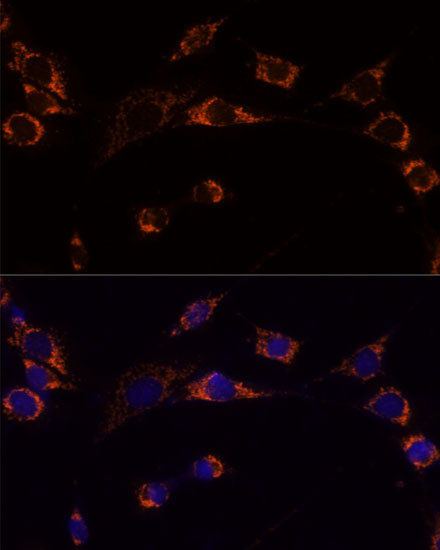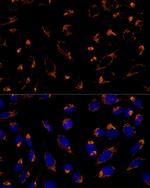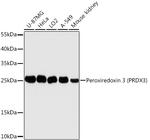Search Thermo Fisher Scientific
产品信息
PA5-116556
种属反应
宿主/亚型
分类
类型
抗原
偶联物
形式
浓度
纯化类型
保存液
内含物
保存条件
运输条件
RRID
产品详细信息
Positive Samples: U-87MG, HeLa, LO2, A-549, Mouse kidney
Immunogen sequence: PAVTQHAPYF KGTAVVNGEF KDLSLDDFKG KYLVLFFYPL DFTFVCPTEI VAFSDKANEF HDVNCEVVAV SVDSHFSHLA WINTPRKNGG LGHMNIALLS DLTKQISRDY GVLLEGSGLA LRGLFIIDPN GVIKHLSVND LPVGRSVEET LRLVKAFQYV ETHGEVCPAN WTPDSPTIKP SPAASKEYFQ KVNQ
靶标信息
Peroxiredoxin (Prx) is a growing peroxidase family, whose mammalian members have been known to connect with cell proliferation, differentiation, and apoptosis. Many isoforms (about 50 proteins), collected in accordance to the amino acid sequence homology, containing active site cysteine residue, and the thiol-specific antioxidant activity, distribute throughout all the kingdoms. Among them, mammalian Prx consists of 6 different members grouped into typical 2-Cys, atypical 2-Cys Prx, and 1-Cys Prx. Except Prx VI belonging to 1-Cys Prx subgroup, the other five 2-Cys Prx isotypes have the thioredoxin-dependent peroxidase (TPx) activity utilizing thioredoxin, thioredoxin reductase, and NADPH as a reducing system. Mammalian Prxs are 20-30 kilodalton in molecular size and vary in subcellular localization: Prx I, II, and VI in cytosol, Prx III in mitochondria, Prx IV in ER and secretion, Prx V showing complicated distribution including peroxisome, mitochondria and cytosol.
⚠WARNING: This product can expose you to chemicals including mercury, which is known to the State of California to cause birth defects or other reproductive harm. For more information go to www.P65Warnings.ca.gov.
仅用于科研。不用于诊断过程。未经明确授权不得转售。
篇参考文献 (0)
生物信息学
蛋白别名: anti-oxidant protein 1; antioxidant protein; Antioxidant protein 1; AOP-1; HBC189; mitochondrial thioredoxin dependent peroxide reductase; mitochondrial Trx dependent peroxide reductase; Perioredoxin-3; Peroxiredoxin III; Peroxiredoxin-3; Protein MER5; Protein MER5 homolog; Prx 3; PRX III; PRX-3; Prx-III; Thioredoxin-dependent peroxide reductase, mitochondrial; Thioredoxin-dependent peroxiredoxin 3
基因别名: AOP-1; AOP1; AW822249; D0Tohi1; Ef2l; HBC189; MER5; PRDX3; PRO1748; prx-III; Prx3; SP-22; SP22; TDXM
UniProt ID: (Human) P30048, (Mouse) P20108, (Rat) Q9Z0V6
Entrez Gene ID: (Human) 10935, (Mouse) 11757, (Rat) 64371






